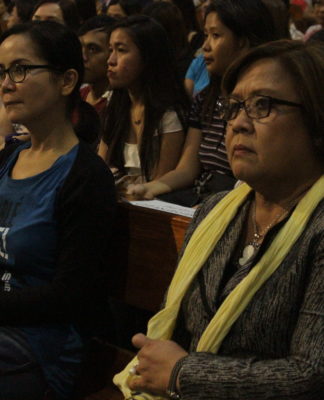 THE CONTROVERSY spawned by a visual art exhibit at the Cultural Center of the Philippines has led to a sort of UST-bashing. Sadly, it came in the wake of the University’s Quadricentennial celebration.
THE CONTROVERSY spawned by a visual art exhibit at the Cultural Center of the Philippines has led to a sort of UST-bashing. Sadly, it came in the wake of the University’s Quadricentennial celebration.
Many people became interested in the exhibit only after television networks had featured it in their newscast. They practically “advertised” it by focusing on a piece of “shock art” that scandalized viewers. By identifying the whole exhibit with this piece, the other more worthy exhibitors were deprived of the recognition they deserved.
It is worth noting that the person who did this shock art piece did not graduate from UST. While attempting to render Marcel Duchamp’s pioneering but controversial art form, what he came up with is a collage that many people viewed as purely scatological, producing an effect similar to what was achieved earlier by Andres Serrano’s “Piss Christ,” a photograph of a crucifix submerged in his own urine; or by Chris Ofili’s depiction of the “Blessed Virgin Mary”, as a black women surrounded by a collage of pornographic images and embellished with elephant dung.
Although the exhibitors were former students of UST, they never informed university authorities about their project. Nor did they bother to ask permission to mount it as “part of the Quadricentennial celebration of the University.” They did not even invite university authorities to watch their exhibit.
Right at the onset of the exhibit, the University, through the kindness of the CCP president, had posted a disclaimer at the site, clearly disowning it. Also, the University had already requested the CCP president to discontinue the exhibit even before a public outcry was raised against it.
Despite this, many people publicly fulminated against the University. One Catholic bishop even declared that he is ashamed of being a UST graduate and renounced his being one. (With the hasty imprudence with which he disowns his alma mater, I am tempted to say: “Good riddance.”)
Like human beings, a university has a good name to protect. And we who were educated in it have the obligation to safeguard its reputaion, instead of smearing it with our reckless actions, or condemning at the slightest provocation. Media people seem to find a wicked delight in implicating UST in every scandal or controversy involving its former students and alumni. Surprisingly, they seldom do this to other universities whose graduates are among the most corrupt and inutile government officials this country has ever known.
Having said this, let me correct the wrong presupposition that underlies the criticisms hurled at a school whenever its graduates stray. People often think of education as a production process, where inputs are transformed into outputs in a standard way. The exemplar of this idea of education is the factory where raw materials are turned into finished products through various processes. Thus, when the product is defective, the factory is blamed for it.
First, we must realize that schooling is not something that is done to students, but as something that students essentially do for themselves. Students are the key factors in shaping educational outcomes. Also, education does not produce a tangible product that is easily measurable. You cannot judge the quality of a school simply by its graduates’ achievements. In fact, educational outcomes often result from a whole range of factors external top the school. Gone were the days when the school and the larger society complement each other in the task of education.
Today, what students learn in school competes with ideas or values prevalent in society. Schools would teach the value of sacrifice, discipline, and self-denial for the sake of long-term goals. But when they go home, television and movies enshrine immediate gratification.
School would teach the long hours of study but movies, the Internet, and television provide an artificial substitute for intellectual simulation. Schools would teach achievement of excellence through painstaking effort and performance. But the movie world, politics, and businesses offer a short cut – Peter’s Principle which states: “An ounce of image is worth a pound of performance.”
It is not surprising, therefore, that students, even before they graduate are already lured to conform with the values dominant in modern society. They develop an attachment to surfaces rather than roots, to collage rather than in-depth work, to a collapsed sense of time and space rather than a true appreciation of history and geography, to an addiction to success rather than dedication and devotion to truth.
Schools certainly want their graduates to embody the values and principles that make us truly human, but other societal forces push powerfully in the other direction. Blaming schools for every indiscretion of its alumni is to presume that it has full control over them. In fact, they don’t. Instead of finger-pointing, the government, the media, the family, and society as a whole, must help the school perform its function by creating a milieu conducive to learning and principled living.














